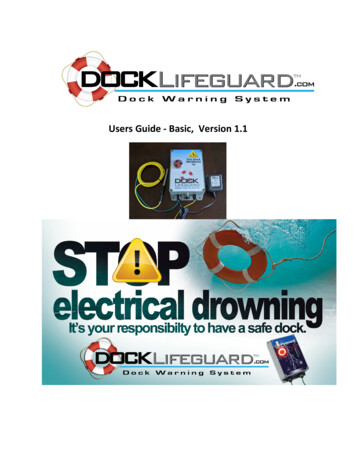
Transcription
Users Guide - Basic, Version 1.1
About this User’s GuideIntroductionThis Dock Lifeguard electricity detection system is an important part of your family’s safety on or aroundyour boat dock.Dock Lifeguard will continuously monitor for electricity around and on your dock and will display awarning strobe and audible alarm to warn you of trouble.Thank you for making Dock Lifeguard a part of your dock safety program. With proper installation anduse, Dock Lifeguard should provide you with years of dependable service.Electricity Detection Safety TipsFollow safety rules and prevent hazardous situations. Schedule annual electrical inspections of yourdock to ensure local codes are met.Keep detectors clean and test them regularly. Replace detectors immediately if they are not workingproperly. Electricity Detectors that do not work cannot alert you to dangerous electricity.Before You Install Your Dock Lifeguard UnitIMPORTANT! Read “Recommended Locations for Dock Lifeguard” and “Locations to Avoid for Detector”before beginning. This unit monitors AC and DC electricity in the water when it reaches its sensingprobe. This unit can ONLY give detection if it is installed, maintained and located where stray electricitycan reach it, and where all residents can hear it, as described in this manual. This unit cannot stop orprevent stray electricity.Know Where to Install Your DetectorDock Lifeguard has a radius range of approximately 40’. It is recommended that the Dock Lifeguard becentrally located with ease of view to ensure proper coverage of your dock. For commercial oroversized residential docks, it is recommended that multiple units be installed on the dock, keepingmaximum distance between detectors to under 80’. Placement near under water bracing and anchorwinch cabling should try be avoided, as stray electricity will find the easiest way to ground and theseitems may shield the probe from sensing the stray voltage.Lake environment (clarity of water and ambient voltage) and dock construction will affect detectionrange. On wood piered construction docks on lakes with ambient voltage of less than 0.2 volts wehave detected voltages at over 100’ away from the probe.By using a method to test the Dock Lifeguard, proper probe placement on the dock can be determined.On large docks or docks constructed on metal piers, multiple Dock Lifeguards may be needed to ensureproper coverage.
Figure 1, Typical Detection RangeKnow What a Stray Electricity Detector Can and Cannot DoA Stray Electricity Detector can alert you to stray electricity on or around your dock. It can only soundan alarm once electricity reaches the detection probe. See “Limitations of Stray Electricity Detectors”for details.Caution Do not paint over the unit. Paint may clog the openings to the siren and prevent the unit fromoperating properly.Do not stand too close to unit when the alarm is sounding. It is loud to alert you in anemergency. Exposure to horn at close range may harm your hearing.Recommended Locations for Dock LifeguardInstall your Dock Lifeguard with an unobstructed view to allow viewing of the warning strobe whenelectricity is detected. Place in a location that is visible from the swimming area around your dock aswell as being easily viewed from the dock and shore. When possible installation unit under roof.Locations to Avoid for DetectorFor best performance, it is recommended you AVOID installing Dock Lifeguard sensing probe in theseareas: Placement of probe directly next to an underwater brace or anchor cabling. The bracing andcables may reduce the range that the probe can reach.Avoid running probe sensing wire parallel to other wires to avoid cross coupling.
Quick Setup GuideInstallation LocationCAUTION: This alarm will only indicate the presence of electricity in the range of the sensor. StrayElectricity may be present in other areas.IMPORTANT: Improper location can affect the sensitive electronic components in this alarm.Sensing Probe LocationThe Sensing Probe lead wire can be lengthened to allow for placement of the probe in the optimallocation on your dock. It is suggest positioning the probe closer to the location under the dock wherepeople are swimming or using the ladder. Place the probe deep enough in the water so that it will stillbe submerged when your lake is in a low water situation.Avoid running sensing wire parallel to other wires to avoid cross coupling.Metal Floating DocksInstallation of Dock Lifeguard unit should be done by mounting the uniton a roof support system (Metal Post) under roof if possible near anoutlet by using metal screws installed through the upper and lowermounted points on the unit. Dock Lifeguard needs to be bonded to thesafety ground system of the dock; this is accomplished through the greenground reference wire on lower installation point on the unit. It isrecommended to bond the ground lead (green wire) of the Dock Lifeguardunit to the frame of the grounded dock and to the ground of the electricalsystem of the dock. Note: You must have a proper bond of the docklifeguard green wire to the dock safety ground for correct operation.Pier Docks with Wood PilingsInstallation of Dock Lifeguard unit should be done by mounting the unit near an outlet under roof ifpossible by using screws installed through the upper and lower mounted points on the unit. DockLifeguard needs to be bonded to the safety ground system of the dock; this is accomplished through thelower installation point on the unit (green ground reference wire). It is recommended to connect theground lead (green wire) of the Dock Lifeguard unit to the electric equipment ground of the receptaclebeing used to power the Dock Lifeguard unit. Note: You must have a proper bond from the DockLifeguard to the dock safety ground.Pier Docks with Metal PilingsInstallation of Dock Lifeguard unit should be done by mounting the unit near an outlet under roof ifpossible by using screws installed through the upper and lower mounted points on the unit. DockLifeguard needs to be bonded to the safety ground system of the dock; this is accomplished through thelower installation point on the unit (green ground reference wire). It is recommended to connect theground lead (green wire) of the Dock Lifeguard unit to the electric equipment ground of the receptaclebeing used to power the Dock Lifeguard unit. Note: Docks constructed with metal pilings may require
multiple Dock Lifeguard systems to get full coverage on the dock as the metal pilings with act as a returnpath to ground for stray electricity, thus not allowing the electricity to travel to the probe installlocation. Note: You must have a proper bond from the Dock Lifeguard to the dock safety ground.Where not to installDo not install in a location which would inhibit viewing the warning strobe or inside a shed which wouldmuffle the sound of the warning siren.Do not install probe directly next to a metal underwater structure such as underwater bracing, seaanchor cables or steel underwater dampening structures.Non-Detection ZonesUnderwater structures such as sea anchors with metal extruding from them or steel pilings can result ina non-detection zones for the Dock Lifeguard. Electricity is very lazy and will find the easiest path toground which may be one of these structures. It is recommended that you determine if thesestructures are around your dock and if so, warn people that swimming in these areas is not safe as thesestructures may attract electricity and shield it from getting to the Dock Lifeguard probe and beingdetected.Figure 2, Floating Dock with Underwater Anchors
Figure 3, Steel Piling DockDepending on your environment, more than one Dock Lifeguard system may be need to insure entirecoverage of your dock area.Having a professional test your environment using a Dock Lifeguard Test Probe can help determine deadzones in your environment.Regular MaintenanceThis unit has been designed to be as maintenance free as possible, but there are a few simple things youcan do to ensure its continued usefulness. For instance, the probe may gather algae after a long time inthe water. Wiping it clean annually will ensure that the range of the probe stays as consistent aspossible. In addition, testing the unit to ensure that all of the LED lights are working properly should bedone regularly.About Your AlarmTest ButtonPressing and holding the Test button will initiate the unit into a test mode during which the siren willsound and the strobe will light. If unit fails the test, check to ensure there is power to the unit. If theunit still fails, please contact Dock Lifeguard for a repair or replacement unit.
Siren VolumeThe volume of the siren can be adjusted by twisting the clear plastic dial on the outside of the RedLight/Siren. Press the test button and twist dial to the desired level.Rotate Clear Ring over Red Light to change Volume Leve;What to Do When Unit AlarmsResponding to an AlarmDuring an alarm you will hear a loud, repeating horn pattern and the red strobe light will flash:WARNING! If the unit alarms and you are not testing the unit, it is a warning of potentially dangeroussituation that requires immediate attention. NEVER ignore any alarm. Ignoring the alarm mayresult in injury or death.What to Do in Case Of AlarmSomeone in the Water Don’t panic; stay calm. Don’t not touch the dock structure Swim away from the electrical source Do NOT jump in the water to help. Throw Life Preserver and instruct party to swim away fromsource. Parties may than be picked up by boat Do not swim to shore as this can be hazardous when stepping out of water to ground.
Out of the Water Don’t panic; Proceed to Shore Kill Power to the dock via the circuit break on the shore Call 911 and your local electricianWARNING!Alarms have various limitations. See “Limitations of Stray Electricity Detectors” for details.Calling a Qualified Electrician to Find and Repair the ProblemIf the Dock Lifeguard units detects stray electricity in the water. Contact a local electrician that isfamiliar with local electrical codes on boat docks to diagnose and solve the problem.If You Suspect a ProblemDock Lifeguard may not operate properly because of faulty power supply or installation in an improperlocation. Clean the Dock Lifeguard as described in “Regular Maintenance”, then test the detector again.If it fails to test properly when you use the test button, or if the problem persists, replace the DockLifeguard unit immediately. If you experience frequent non-emergency alarms:o Check and Measure for electricity in the watero Very proper for proper safety ground bonding of your dock.Technical InformationLethal Voltage is 2 volts AC per foot. The Dock Lifeguard units are setup to trigger at approximately1500 millivolts. To see exact settings of your system, you need to reference the sensitivity jumpersettings on the mother board and trigger level of the alarm, as these items are configurable.The following link a reference to the USCG In-Water Shock Hazard Mitigation fProduct SpecificationsSensitivity meter is in 125 millivolt levels. Sensitivity can be increased by setting jumpers on themother board. Refer to YouTube video on the DockLifeguard.com website on how to set the jumpers.How the Unit Determines When to AlarmThe default factory setting of the Dock Lifeguard will trigger when stray electricity is detected in thewater above the unit threshold of approximately 1500 millivolts. This trigger sensitivity will increasewith increased levels sensitivity via the sensitivity jumpers and trigger point adjustments made on themotherboard. Alarm Trigger Level: The trigger level of the alarm can be adjusted to helpfilter out higher levels of ambient voltage in the water or to alarm at a
lower level of voltage. Trigger level is based on the number of LED lit, notvoltage being read. Value of voltage for each lit LED is based on thesensitivity jumper settings.Adjusting Alarm Trigger LevelFactory setting is set to trigger alarm when 4 LEDs are lit. Alarm trigger pointcan be raised by turning the potentiometer counter clockwise and lowered byturning the potentiometer clockwise. Around a 10-degree turn will changetrigger level by one LED. The voltage that corresponds to the number of litLEDs can be determined by sensitivity jumper settings on the motherboard.
Sensitivity: Internal Jumpers allow for adjusting the sensitivity level of theDock Lifeguard unit. The more sensitive the setting, the further out theDock Lifeguard will detect stray voltage.X0 – Nothing Jumped, each LED 0.5 VoltsX1 –Jumped, each LED 0.25 Volts
X2 –Jumped, each LED 0.20 VoltsX3 – (X1 & X2) Jumped, each LED 0.125 VoltsNote: For lakes that have a higher amount of Ambient Voltage (for example, 2Volts is common on Smith Lake, AL). Sensitivity will need to be decreased andthe Alarm level raised in order to filter out the ambient voltage. Withdecreased sensitivity comes decreased range of detection. It is recommendedto install the Dock Lifeguard sensing probe closer to the area of the dockwhere the ladder is and where swimming activity takes place.
Limitations of Stray Electricity DetectorsA Stray Electricity Detector can play a key role in reducing deaths resulting from stray electricity.However, like any warning device, Dock Lifeguard can only work if it is properly located, installed, andmaintained, and if stray electricity reaches it. They are not foolproof.Dock Lifeguard cannot work without power. The Dock Lifeguard unit is powered with an AC power plugdelivering DC power to the unit. In the case of AC power plug failure, the unit will be inoperable.Dock Lifeguard cannot detect electricity if electricity does not reach the probe. Proper placement ofthe sensing probe on your dock is crucial to the detection of electricity in the water around your dock.Electricity is lazy, it will find the easiest path to ground. If the probe is located on the opposite side of acable or brace, the stray electricity in the water may find its way to ground through the bracing orcabling on not reach the probe for the Dock Lifeguard to emit a warning. If you may want to installmultiple units on the dock to insure proper coverage.Dock Lifeguard may not be heard. Though the alarm horn in this units meets or exceeds currentstandards, it may not be heard if: 1) the unit is located inside a closed shed, 2) residents recentlyconsumed alcohol or drugs, 3) the alarm is drowned out by noise from stereo, TV, traffic or other loudambient noise, 4) residents are hearing impaired.Stray Electricity Detectors are not foolproof. Like any electronic device, Dock Lifeguard is made ofcomponents that can wear out or fail at any time. You must test the unit weekly to ensure yourcontinued protection. Dock Lifeguard cannot prevent leaking electricity from other sources. It is not asubstitute for property or life insurance.Current Detectors have a limited life. The unit should be replaced immediately if it is not operatingproperly. A qualified electrician using proper test equipment can test the operation of the unit bytemporarily injecting stray electricity into the water around your dock. WARNING: In water testingshould never be performed if any human or animals are in the water within 100 yards of your dock.Limited WarrantyDock Lifeguard, LLC, the maker of Dock Lifeguard warrants that the following model be free from defectsin material and workmanship:Dock Lifeguard, LLC, at its option, will repair or replace this product or any component of the productfound to be defective during the one-year warranty period. Replacement will be made with a new orremanufactured component of the product. If the product is no longer available, replacement may bemade with a similar product of equal or greater value. This is your exclusive warranty.This warranty is valid for the original retail purchaser from the date of initial retail purchase and is nottransferable. Keep the original sales receipt. Proof of purchase is required to obtain warrantyperformance. Dock Lifeguard dealers, service centers, or retail stores selling Dock Lifeguard products donot have the right to alter, modify or any way change the terms and conditions of this warranty.
This warranty does not cover normal wear of parts or damage resulting from any of the following:neglect use or misuse of the product, use on improper voltage or current, use contrary to the operatinginstructions, disassembly, repair, or alteration by anyone other the Dock Lifeguard, LLC or an authorizedservice center. Further, the warranty does not cover Acts of God, such as fire, flood, hurricanes andtornadoes or any batteries that are included with this unit.Dock Lifeguard, LLC shall not be liable for any incidental or consequential damages caused by the breachof any express or implied warranty. Except to the extent prohibited by applicable law, any impliedwarranty of merchantability or fitness of a particular purpose is limited in duration to the duration of theabove warranty. Some states, provinces or jurisdictions do not allow the exclusion or limitation ofincidental or consequential damages or limitation on how long a implied warranty lasts, so the abovelimitations or exclusion may not apply to you. This warranty gives you specific legal right, and you mayalso have other rights that vary from state to state or province to province.Your Dock Lifeguard Alarm is not a substitute for property, disability, life or other insurance of any kind.Appropriate insurance coverage is your responsibility. Consult your insurance agent.For Warranty Service: In many cases the quickest way to exchange your alarm is to return it to theoriginal place of purchase. If you have questions, call the Dock Lifeguard customer service department at1-573-434-6453 for assistance.Frequently Asked QuestionsHow many detectors do I need on my Dock?Dock Lifeguard will monitor for electricity in the water within a forty-foot radius from the sensing probe.For docks that are wider or longer than 80 feet it is recommended to install multiple detectors to ensureadequate coverage. If your dock has underwater cabling or a lot of steel underwater bracing orconstructed on metal piers, more units may be need to insure detection as these structures will reducethe detection range. Note: Range can very upon the concentration of ions and minerals in the water.My detector sounds when I turn on my boat lift control box?When brushes for blower motors start to wear, they can leak electricity back to ground which isdisplayed on the Dock Lifeguard unit. Replacing worn blower motors should correct the issue.Can the sensitivity be changed on the Dock Lifeguard Unit?Yes, the Dock Lifeguard units have four levels of sensitivity which can be set by a qualified DockLifeguard technician.Can the alarm trigger point be changed on the Dock Lifeguard Unit?Yes, the Dock Lifeguard alarm point can be changed by a qualified Dock Lifeguard technician.
Upon installation, my units is alarming but I know my dock is wired correctly,why is this?Most likely it is an improper bonding issue. Have your safety ground bonding system checked by aqualified electrician.My unit is alarming, and I have checked my safety ground bonding system .where is the stray electricity coming from?The Dock Lifeguard Unit is designed to detect any stray electricity whether it is at a lethal or non-lethallevel. Below are listed a few scenarios which may add in determining where your stray electricity iscoming from:--Dock De-Icers: Water aerators placed in the water are susceptible to leaking strayelectricity in the water. If your unit is detecting stray electricity around your dock, tryisolating the De-Icer unit that is causing the problem by unplugging your or your neighborsDe-Icer and seeing if the stray electricity goes away.Underwater Water Pumps: Underwater water pumps are subject to leaking electricity inthe water. A lot of these underwater pumps are 220Volt and are ran on non-GFCI’dbreakers. If you are using an submersible water pump, it may be a good time to changeit out to an above water pump. Current trend of governing bodies of lakes is to disallowunderwater pumps and only allow above water pumps.-Ambient Voltage of Water: Each body of water will inherently have some small level ofelectricity in it. In most lakes this is between 0.05 and 1 volt. Depending on yoursensitivity settings of your unit, then number of LEDs shown on the front of the displaywill reflect this ambient voltage. i.e. You sensitivity jumper setting is set to 0.25 volts andyou have 0.8 volts of ambient voltage in the water, then 3 LEDs will be lit on the DockLifeguard. Note: Ambient voltage of your lake can be checked by using a standard voltmeter and placing one lead in the water and the other touch the GROUND plug of anoutlet.-Back Feed from your Home: If you have a well-grounded dock with a grounding rod 25ohms, but your homes grounding rod is above the 25 ohm threshold, your electricalsystem may run into the situation where non-lethal stray electricity from your home (i.e.From a A/C Unit or Heat Pump) may bypass the home’s grounding rod and feed down tothe grounding rod with lower resistance (The Dock) which is tied to your dock. To correctthis situation you will need to correct the ground resistance of your home’s grounding rod,or you can run an isolated grounding rod to feed the Dock Lifeguard unit. In certain areasof the country where hard water is prevalent, the heating element of yours (or yourneighbors) may short out and put electricity back on the ground wire which can be backfed down to your dock.-It may not be your house or dock: Any nearby house or dock that shares the same safetyground from a shared transformer has the potential of putting hazardous electricity backon the ground wire and then having it back fed to your dock. Not only check your house,but check surrounding houses and docks for stray electricity.
can reach it, and where all residents can hear it, as described in this manual. This unit cannot stop or prevent stray electricity. Know Where to Install Your Detector Dock Lifeguard has a radius range of approximately 40'. It is recommended that the Dock Lifeguard be centrally located with ease of view to e nsure proper coverage of your dock.











